
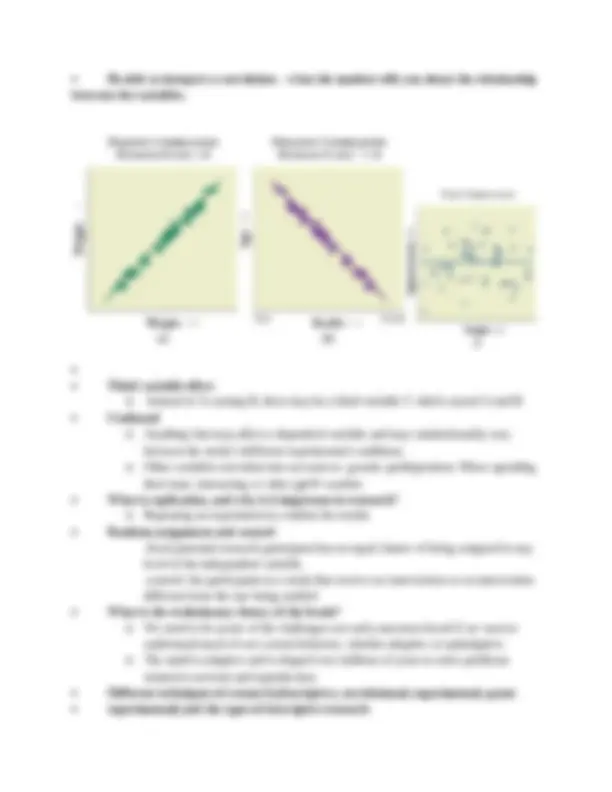
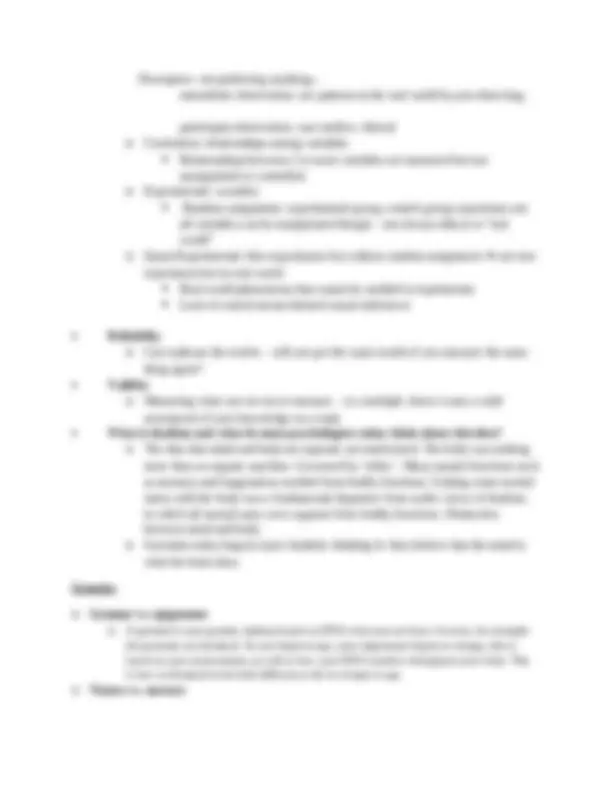
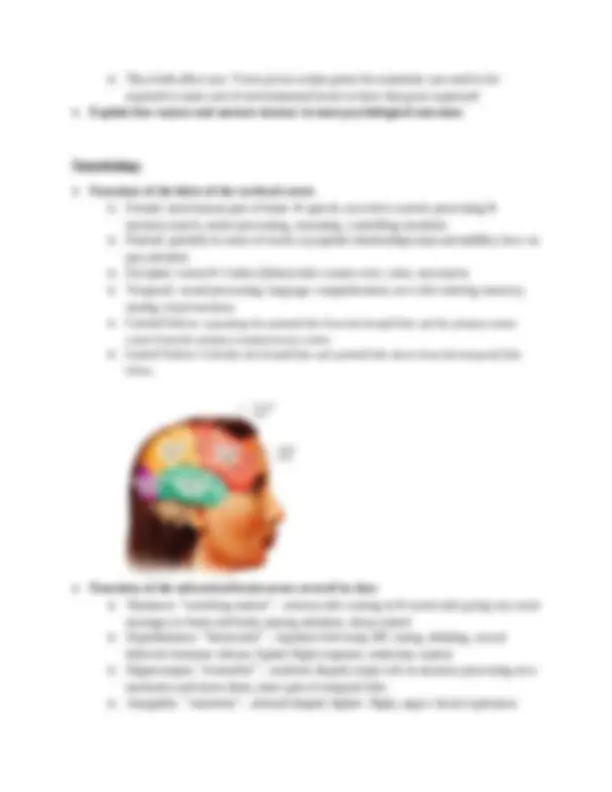
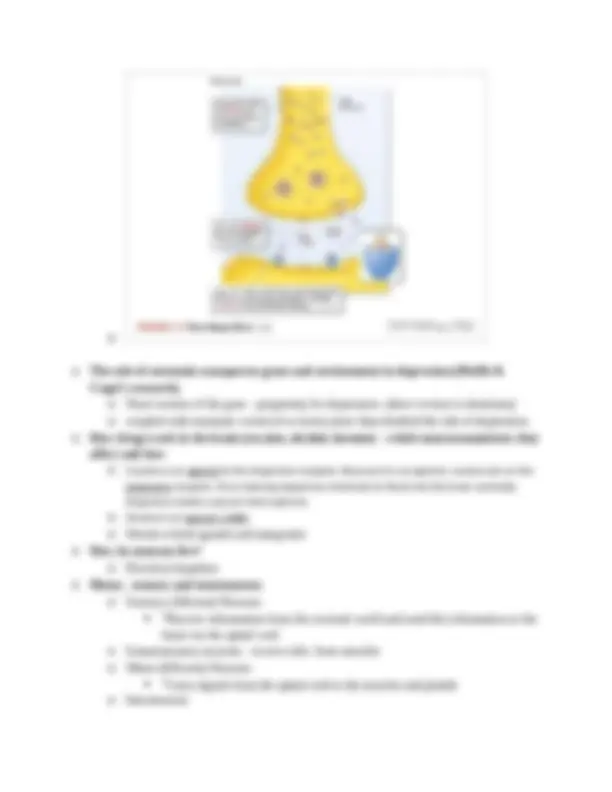
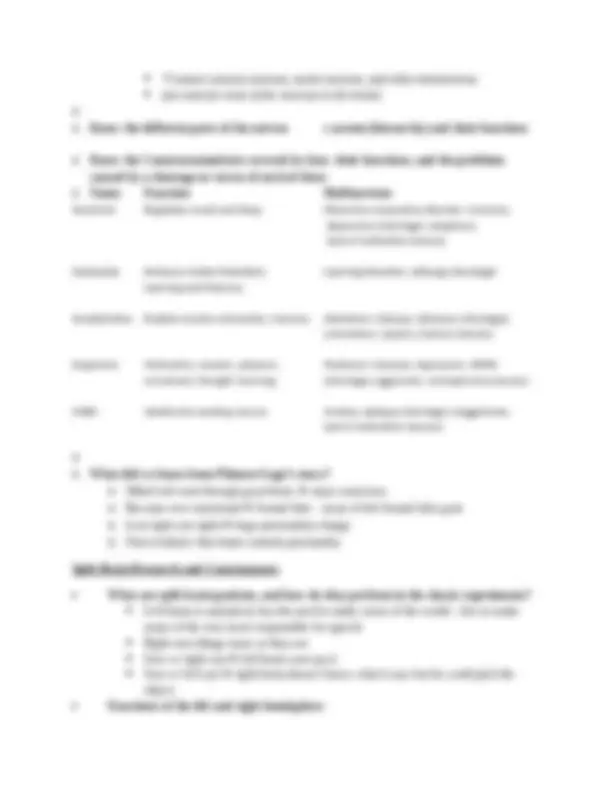
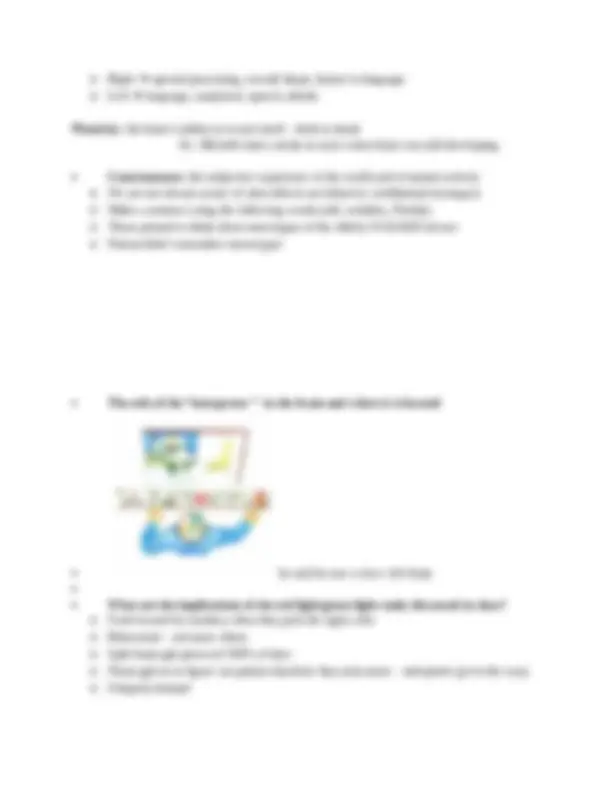


Study with the several resources on Docsity

Earn points by helping other students or get them with a premium plan


Prepare for your exams
Study with the several resources on Docsity

Earn points to download
Earn points by helping other students or get them with a premium plan
Community
Ask the community for help and clear up your study doubts
Discover the best universities in your country according to Docsity users
Free resources
Download our free guides on studying techniques, anxiety management strategies, and thesis advice from Docsity tutors
Exam 1 study guide Material Type: Notes; Professor: Caldwell; Class: General Psychology; Subject: Psychology; University: Ithaca College; Term: Spring 2010;
Typology: Study notes
1 / 11

This page cannot be seen from the preview
Don't miss anything!







General Psychology, Fall 2010 Study Guide: Exam Intro and Research Methods What is psychological science? It is an empirical science Nature and Nurture are inextricably entwined The brain and mind are inseperable A new biological Revolution is Energizing Research The Mind is Adaptive Psychological science Crosses Levels of Analysis We often are Unaware of the Multiple Influences on How we Think, Feel and Act Scientific method 1.Specify a problem (theory) 2.Systematic observation Collect Data – “pilot phase” 3.Form a hypothesis 4.Test the hypothesis Operational definition – specify what you will measure 5.Formulate a theory – based on previous data 6.Test the theory Distinguish between Hypothesis and theory Form a hypothesis: a specific, testable prediction about the outcome that would best support the theory. “Nature-deficit” may aggravate attentional difficulties of young children (including those with ADHD).” Formulate a Theory: a model of interconnected ideas and concepts that explains what is observed and makes predictions about future events. “Being in nature/outdoors is essential to human well-being.” The levels of analysis in psychological science (covered in week 1), and how they can be applied in considering the causes for depression. 1.Biological – brain chemistry, cells, genes, 2.Individual – thoughts, feelings, beliefs, desires 3.Social – relationships and groups 4.Cultural – different cultures shape thought, feelings, actions differently: fast past vs. rural slow 5.Environmental – climate, location
Distinguish between correlational and experimental research: o Differences between them Correlation: examines how variables are naturally related in the real world without any attempt by the researcher to alter them. Relationships between 2 or more variable are measured but not manipulated or controlled. Rely on naturally occurring Experimental: Maximal control over experiment. The researcher manipulates one variable to examine the variables effect on a second variable. o Which has control experimental o Independent and dependent variables IV- intentionally varied while another variable is measured (the treatment or condition) (number of hours worked) DV-the variable that is measured while the independent variable is changed (the outcome)(how much women want to have fun after work) o What is random assignment? Not controlling who get what treatment or who is exposed to the IV or DV When each potential research participant has an equal chance of being assigned to any level of the independent variable. o Causality vs. correlation Causality/true experiment = effect Correlation does not = effect ; cannot describe “causes” o Why is experiment preferred over correlational research The researcher can study the casual relationship between the 2 variables. F the independent variable influences the dependent variable consistently, then the independent variable is assumed to cause the change in the dependent variable. Just because 2 things show the same correlation doesn’t mean that theyre related or that they caused each other. o In what cases might correlational research be chosen over an experiment? They rely on naturally occurring relationships. Some research questions require correlation research deigns for ethical reasons. When you just have 2 variables but you cannot test them.
Descriptive: not predicting anything-- naturalistic observation- see patterns in the real world by just observing; participant observation; case studies- clinical o Correlation: relationships among variables Relationships between 2 or more variables are measured but not manipulated or controlled. o Experimental: causality Random assignment: experimental group, control group; sometimes not all variables can be manipulated though – not always ethical or “real world” o Quasi-Experimental: like experiments but without random assignment not true experiment but its real world Real-world phenomena that cannot be studied in experiments Lack of control means limited casual inferences Reliability o Can replicate the results – will you get the same results if you measure the same thing again? Validity o Measuring what you set out to measure – is a multiple choice exam a valid assessment of your knowledge on a topic What is dualism and what do most psychologists today think about this idea? o The idea that mind and body are separate yet intertwined. The body was nothing more than an organic machine. Governed by ‘reflex’. Many mental functions such as memory and imagination resulted from bodily functions. Linking some mental states with the body was a fundamental departure from earlier views of dualism, in which all mental sates were separate from bodily functions. Distinction between mind and body. o Scientists today largely reject dualistic thinking bc they believe that the mind is what the brain does. Genetics o Genome vs. epigenome o A genome is your genetic makeup based on DNA when you are born. In twins, for example the genomes are identical. As you begin to age, your epigenome begins to change, this is based on your environment, as well as how your DNA transfers throughout your body. This is how to identical twins look different as the two begin to age. o Nature vs. nurture
o They both affect you. Youre given certain genes but sometime you need to be exposed to some sort of environmental factor to have that gene expressed. o Explain how nature and nurture interact in most psychological outcomes Neurobiology o Functions of the lobes of the cerebral cortex o Frontal: most human part of brain speech, executive control, processing memory search, motor processing, reasoning, controlling emotions o Parietal: partially to sense of touch; rep spatial relationships (top and middle), how we pay attention o Occipital: vision 2 sides (2lobes) info crosses over; color; movement o Temporal: sound processing; language comprehension; new info entering memory; storing visual memory o Central Sulcus: separating the parietal lobe from the frontal lobe and the primary motor cortex from the primary somatosensory cortex. o Lateral Sulcus: It divides the frontal lobe and parietal lobe above from the temporal lobe below. o Functions of the subcortical brain areas covered in class o Thalamus: “switching station” – sensory info coming in motor info going out; route messages to brain and body; paying attention; sleep control o Hypothalamus: “thermostat” – regulates bob temp, BP, eating, drinking, sexual behavior hormone release; fighter flight response; endocrine system o Hippocampus: “remember” – seahorse shaped; major role in memory processing new memories and stores them; inner part of temporal lobe o Amygdala: “emotions” – almond shaped; fighter- flight; anger; facial expression
o How agonists and antagonists work o Agonists: drugs or toxins that ‘enhance’ neurotransmitters o o Antagonists: drugs inhibiting these actions
o o The role of serotonin transporter genes and environment in depression (Moffit & Caspi’s research) o Short version of the gene - propensity for depression (short version is dominant) o coupled with traumatic events (4 or more) more than doubled the risk of depression. o How drugs work in the brain (cocaine, alcohol, heroine) – which neurotransmitters they affect and how o Cocaine is an agonist to the dopamine receptor. Because it is an agonist, cocaine sits on the dopamine receptor, thus inducing dopamine chemicals to flood into the brain and body. Dopamine makes a person feel euphoria. o Alcohol is an agonist. GABA o Heroin is both agonist and antagonist o How do neurons fire? o Electrical impulses o Motor, sensory and interneurons o Sensory (Afferent) Neurons: °Receive information from the external world and send this information to the brain via the spinal cord o Somatosensory neurons – receive info. from muscles o Motor (Efferent) Neurons: °Carry signals from the spinal cord to the muscles and glands o Interneurons:
o Right special processing, overall shape, humor in language o Left language, analytical, speech, details Plasticity: the brain’s ability to rewire itself – birth to death Ex. Michelle had a stroke in utero when brain was still developing. Consciousness: the subjective experience of the world and of mental activity o We are not always aware of what affects our behavior. (subliminal messages) o Make a sentence using the following words (old, wrinkles, Florida) o Those primed to think about stereotypes of the elderly WALKED slower o Patient didn’t remember stereotypes The role of the “interpreter “ in the brain and where it is located he said he saw a claw: left brain What are the implications of the red light/green light study discussed in class? o Food reward for monkey when they pick the right color o Behavioral – red more oftern o Split brain ppl press red 100% of time o Norm ppl try to figure out pattern therefore they miss more – interpreter get in the way) o Uniquely human!